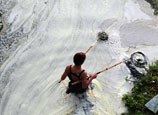
THE HAGUE, May 24 (Xinhua) -- A well thought-out plan altered the development of talents and coaches in Germany over the past fifteen years, with German soccer currently reaping the fruits of that transition.
For the first time in history two German clubs feature in the Champions League final on Saturday, Bayern Munich and Borussia Dortmund, and in addition both teams play attractive soccer with a high number of young, technical, home-grown German players.
The clubs followed the same path as the German national team, which transformed into a technical, attacking formation in the past decennium. Germany's coach Joachim Loew now has the luxury of being able to pick the likes of Thomas Muller (23), Toni Kroos (23), Mario Gotze (20), Marco Reus (23) and many more.
"Our style of soccer changed from a very physical level to a more technical philosophy," Ulf Schott, director of youth and education at the German football association DFB, told Xinhua.
According to Schott the transition was the result of a well thought-out strategy, which started fifteen years ago. In 1998 Germany reached the quarter-finals of the World Cup with an over-aged team, and two years later at Euro 2000 the Germans, with an average age of 30 years, were ousted in the group phase. Everyone connected with German football had come to realize something had to change. Schott started as youth coach at the German football association in 1997 and experienced the crisis at first hand.
"After the 1998 World Cup the alarm bells were ringing," Schott said. "Until that time youth football was not so high on the agenda. During discussions it was said that it was important, but if you would ask for money for coaches it was not that important. After 1998 support arose to examine and develop a program, in cooperation with the regional associations and clubs."
The DFB and the clubs acknowledged that the development of more technically gifted homegrown players would be in everyone's interest. With the French and the Dutch national teams being more successful and more appealing at that time the DFB did not hesitate to take a look at best practices in these countries, well-known for their structured youth approach.
"We exchanged information with countries like the Netherlands, France and also Spain, but we thought out and developed our own program, tailor-made for Germany," Schott explained.
"You cannot compare our situation with other countries, the circumstances are different. France has a more centered approach with their performance center in Clairefontaine. The Netherlands has a lot of fulltime coaches, which is very important. We learned from that. After 1998 we looked at developments in France and the Netherlands, but we did not want to copy their systems."
The DFB developed a long-term plan, in three phases, starting at the bottom, at the grassroots. The first step was to restructure the regional associations. The federal system of Germany was also visible in the sport, with each of the 21 regions having its own way of scouting and developing.
"There was no unique and systematic way," Schott said. "We thought every talent in Germany should have the chance to be scouted. From 1999 to 2001 we therefore established 120 regional talent centers and in the years after Euro 2000 this was increased to the current amount of 366 talent centers. A total of 1000 youth coaches have the task to train and invite talents."
"The first step was a wide approach, with attention to scouting and talent development," the DFB youth director added. "The regions were the first step and the second step were the clubs. We brought up criteria which every club should fulfill. We wanted the clubs to establish a youth academy with professional coaches in order to give our talents the best chances to be educated and developed. Since 2001 every club of the First Bundesliga and since 2002 every club of the Second Bundesliga must have a youth academy. That means, they must adhere to a list of criteria like having full-time coaches or professional training fields, cooperating with a school or having a talent program."
"The third step was to cooperate with schools," Schott said. "We want talents to have training in the morning, but they should also go to school. They also should finish their school exams. We are convinced self-confidence of children should not only be based on football, but also on other areas. With this third step we started in 2006."
Due to the changes the number of training sessions increased at the youth academies, while the establishment of youth coach licenses in 2003 raised the quality of training. The number of fulltime youth coaches at the youth academies increased from 100 to 400. In addition, a total of 1000 licensed part-time youth coaches are working at the regional training centers, which are destined for children aged 8 to 14 from professional and amateur clubs for weekly trainings. On a regular basis all these coaches meet and talk about football and think about tactics. In 2006 the DFB also installed Matthias Sammer as sporting director to further organize the transition and in 2012 Sammer was succeeded by Robin Dutt.
"The technical abilities of the talents increased due to more training and better training," said Schott. "The first fruits of the transition could be noticed at the World Cup in 2006 and the following tournaments in 2008 and 2010. We found that the average age of the national team decreased from 31 in 2000 to 25 in 2010."
"The number of young players and home-grown Bundesliga players in the first team doubled from 2001 to 2011. Now it's OK to go for the youth. Bayern and Borussia have enough players in their team from their own academy. The best example might be Freiburg, around forty percent of their players come from their own academy. Seven years ago they concentrated on the youth and now they reap the fruits of that policy."
The new policy did not lead to new trophies yet for the national team, but on Saturday the most prestigious Cup on club level will definitely go to Germany again. On youth training level, winning is not the only important thing.
"I think a mixture of winning and developing is ideal. If the technical and tactical abilities of the players are better they will be better than the opponent. Both depend on each other, but results cannot predict the future of a talent. I would say until the age of 14-16 the individual approach is more important and after that team success will be in the center of attention. After 16 you can put on more pressure."
The number of regional centers, youth academies, coaches increased, but the organization of the youth leagues also changed. In 2003 a youth league for Under 19 teams was established, centrally organized with 42 teams divided into three leagues. Before that time Germany only had regional youth leagues. Since 2008 the same system was organized for Under 17 teams. The DFB is not planning to do the same for Under 16 or Under 15.
"We examined our numbers and we think it is not good to concentrate all the best players too much or too early," declared the head of youth. "So in our opinion one national league for Under 19 seems not a good idea. Also we think for Under 16 we should have more widespread leagues. We examined that 50 percent of the players in the Bundesliga did not play at a professional club at the age of 14-15. The other half played at amateur clubs. So if we start a national league at that level the danger is that you miss out on these amateur talents. Therefore we should not concentrate too early."
More than a decade after the DFB searched for best practices around the world other nations are coming to Germany for advice and are even trying to copy the method. But copying the method will according to Schott not be simple due to different circumstances, the size of the country, the accommodations and will also not be cheap. The German professional clubs spend 100 million on the youth academy and the DFB currently adds 20 million euros per year. The situation in Germany has already led to some envious looks from other countries. Also from countries from which the Germans partly took over their system, like the Netherlands.
"Half the world visited the Netherlands to hear how we develop our youth players and organize our youth football," said Mohammed Allach, technical manager of the KNVB, last year in Dutch newspaper Algemeen Dagblad.
"We shared our knowledge, without taking new steps ourselves. I have the feeling that football-playing Netherlands does not see the urgency of what is going on. In many places in Europe but also in Asia, leagues and clubs can work with more financial resources than we do with a greater potential of talents because they have more inhabitants."
"Germany has changed the structure of their youth leagues, with the best players now competing against each other, while reserve teams for fresh seniors are integrated in the senior leagues," Allach added.
"At the same time they started to educate coaches, developed a new way of scouting and playing. Their national teams now want to have possession of the ball, play creative football and dominate like us. A new generation of players and coaches will grow up with this system. The result is that the training of German talent is already no longer parallel to ours. The route in Germany is longer and more challenging and also ends in a top competition like the Bundesliga, while our talents debut in the Dutch Eredivisie. The difference will only increase in the coming years."
DFB youth director Schott does not think the Germans may be certain of dominating football in the forthcoming years. "I would not say our youth academy is better now than the Dutch one," he said. "I think it's not that simple. The Netherlands is a small country, but they have produced enough quality players and still do. If professional clubs and regions work together they have a good chance of maintaining their good developing system."
"The reason for the current German successes is in my opinion indeed the transition in 1998/2000, but we must keep cool. Now it is OK, but we have to develop, because other countries also develop themselves. You have to do more, have to take new steps. What could be better is the management of the know-how. It is important to collect the know-how of each coach and transform it into knowledge for every coach in Germany. We also have to keep innovating," he said.
















 Couple say 'I do' after 35-year wait
Couple say 'I do' after 35-year wait


![]()
